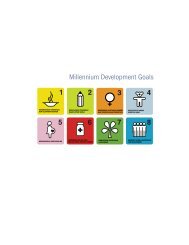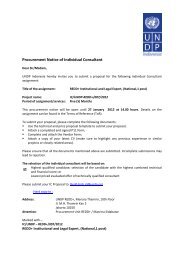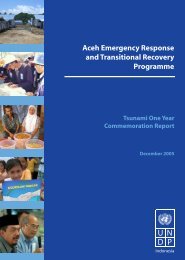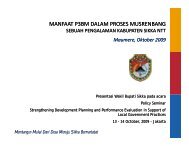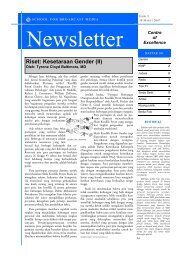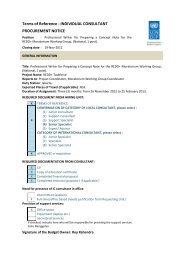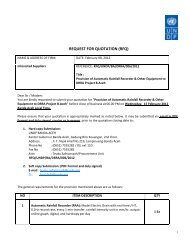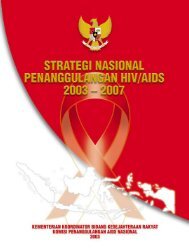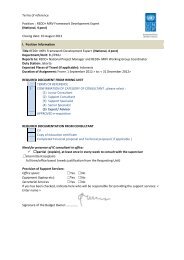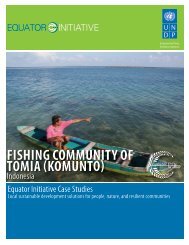Papua Needs Assessment - UNDP
Papua Needs Assessment - UNDP
Papua Needs Assessment - UNDP
Create successful ePaper yourself
Turn your PDF publications into a flip-book with our unique Google optimized e-Paper software.
Executive Summary<br />
With more than 250 different linguistic groups and a vast land area rich in natural resources,<br />
<strong>Papua</strong> presents unique challenges and opportunities for human development. Despite its<br />
extraordinary cultural and natural resources, <strong>Papua</strong> ranks as the lowest province in the Indonesian<br />
Human Development Index (2004) and is lagging behind most other provinces in the key indicators<br />
used in measuring progress toward the achievement of the Millennium Development Goals (MDGs).<br />
Key development challenges include widespread poverty, limited economic opportunities, the<br />
spread of diseases (such as HIV/AIDS, tuberculosis, and malaria), and the poor level of education.<br />
With this in mind, in 2004 the Government of Indonesia requested the United Nations Development<br />
Programme (<strong>UNDP</strong>) to facilitate a needs assessment to examine the situation in <strong>Papua</strong> and<br />
review the implications for programmes to further human development there. The <strong>Papua</strong> <strong>Needs</strong><br />
<strong>Assessment</strong> (PNA) was undertaken in collaboration with local <strong>Papua</strong>n partners and other national<br />
and international consultants over 12 months between August 2004 and May 2005. The <strong>UNDP</strong>’s<br />
point of departure was <strong>Papua</strong>’s Grand Strategy, the framework through which provincial government<br />
has expressed its view of <strong>Papua</strong>’s needs and priorities. The key areas for attention in the Grand<br />
Strategy are health, education, livelihoods and basic/community infrastructure, which are clearly<br />
and directly consistent with the MDGs, to which the government has affirmed its commitment.<br />
For the PNA, the State University of <strong>Papua</strong> (UNIPA) and Cenderawasih University (UNCEN)<br />
conducted assessments of local government capacities, with a focus on service delivery in health,<br />
education, infrastructure and livelihood-related services in 17 kabupatens, including 8 newly formed<br />
kabupatens. <strong>Papua</strong>n non-government organizations (Yalhimo, Yayasan Almamater, Yayasan<br />
Pembangunan Masyarakat Desa and Perdu) carried out assessments of village conditions and<br />
community livelihoods in 17 kabupatens, and analysed selected civil society organization (CSO)<br />
capacities related to community livelihood needs and aspirations. Other consultants reviewed<br />
the status of governance and public finance , gender issues and environmental management, to<br />
complement the work done by local partners. A multi-stakeholder team referred to as the Synthesis<br />
Team, or “Tim Sintese”, reviewed this work and developed a synthesis of the development situation<br />
in <strong>Papua</strong>, which is available separately from this overview of the PNA.<br />
This document summarises the <strong>UNDP</strong>’s understanding of the main PNA findings, beginning with<br />
an overview of cross-cutting social, cultural, environmental and economic dimensions, then<br />
presenting governance issues related to development and finally the provision of education, health,<br />
community livelihoods, and infrastructure. Issues of capacity, development coordination and<br />
lessons from the PNA process are summarized as a reference for all stakeholders committed to<br />
human development in <strong>Papua</strong> and for consideration in the preparation of future policies and<br />
programmes. A recommendation for a framework for development assistance to improve individual,<br />
institutional and societal capacities in <strong>Papua</strong> is outlined in the concluding section.<br />
Based on a review of the existing quantitative secondary data and a rich set of qualitative information<br />
drawn from field assessments, the main picture of <strong>Papua</strong> emerging from the PNA is one of: 1<br />
• Low local government capacity for policy-making, planning and delivering basic<br />
services outside the main cities or towns<br />
• Little local government accountability<br />
1<br />
Data integrity is low in <strong>Papua</strong> and presents a major constraint to quantifying a baseline and monitoring changes<br />
over time. Some of the official (BPS) data for <strong>Papua</strong> differs from one report to another, and presents a very<br />
different picture than that emerging from information that was collected directly from kabupaten agencies and from<br />
village communities during the PNA.<br />
1



